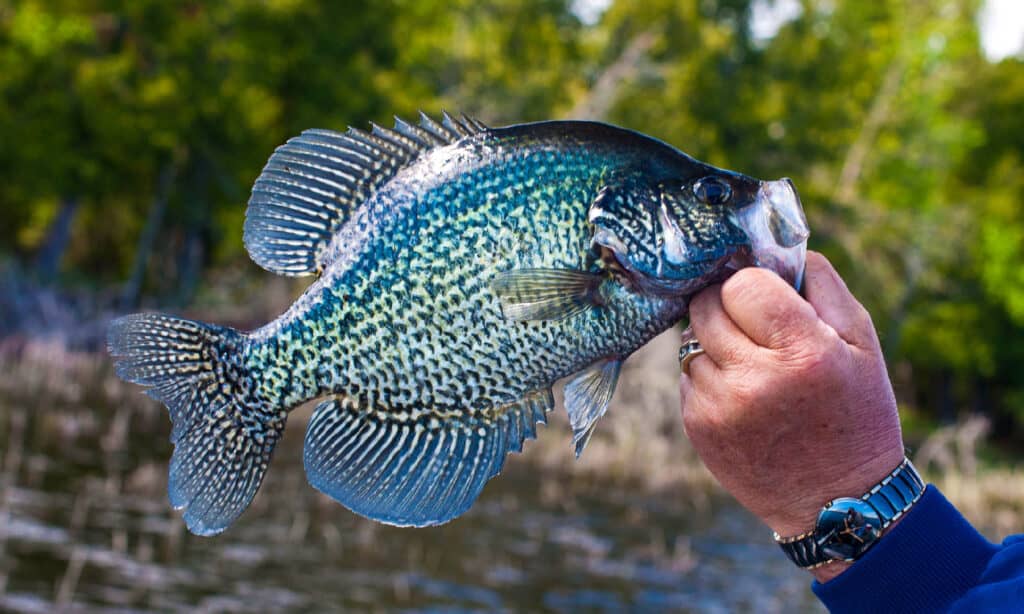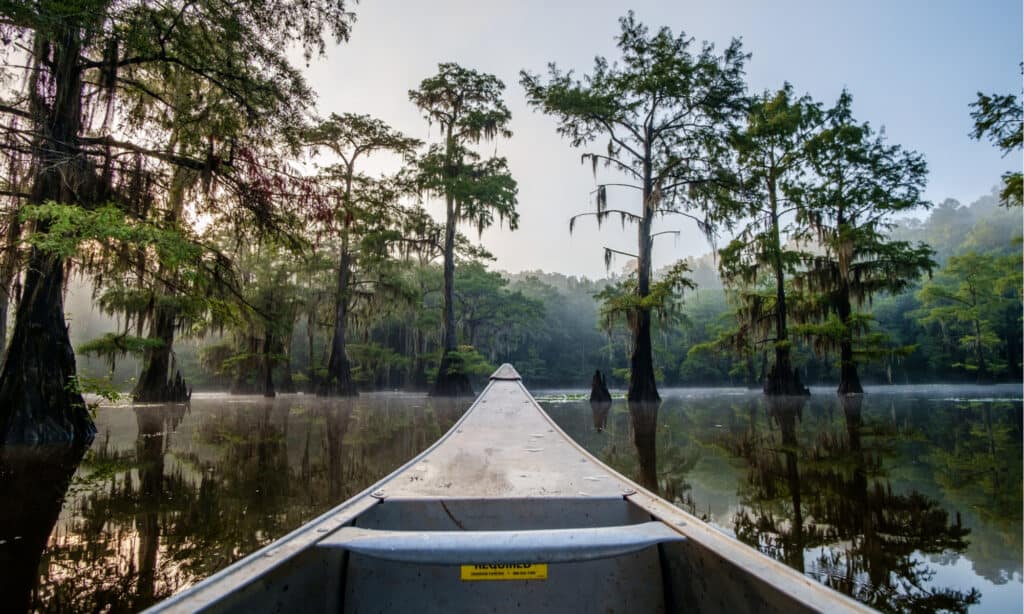The black crappie is a freshwater fish belonging to the sunfish family, found in most parts of North America. It resembles the white crappie in size and behavior, though the black crappie has a darker coloration with irregular and scattered black splotchy spots.
The Largest Black Crappie Ever Caught In Louisiana
The largest ever recorded black crappie in Louisiana weighed 3.84 pounds. Randy K. Causey caught this crappie at Poverty Point Resort in April 2010.

The Largest Black Crappie Ever Caught In The World
According to the International Game Fish Association, the world’s largest black crappie weighed 5 pounds and 7 ounces. Lionel Ferguson caught the crappie in Richeison Pond near Paint Rock town in Tennessee.
Physical Characteristics Of Black Crappies

The black crappie has dark spots on the caudal, anal, and dorsal fins.
©iStock.com/SteveOehlenschlager
To quickly identify black crappie, look for the following characteristics:
- seven to eight spines along the dorsal fin
- laterally compressed body
- dark spotted pattern on the caudal, anal, and dorsal fins
- big mouth with thin lips
Black crappies live in navigation pools, lakes, borrow pits, and reservoirs. They prefer habitats in areas with clear, calm water, mud or sandy bottoms, and abundant aquatic vegetation.
Reproduction And Life Cycle Of Black Crappies
Black crappies reach maturity between two and four years. Their growth rate is faster in warm waters than in the cooler waters of the north.
The best breeding temperature ranges between 58- and 68 degrees Fahrenheit. Usually, the males build nests for spawning during spring and early summer. They create the nests by sweeping out sand or mud near the shoreline using their bodies and tails. Female crappies can produce up to 40,000 eggs, depending on age and size. After spawning, the male watches the nests until the eggs hatch (which takes two to three days). The hatched larvae move to the shallow sheltered water after a few days.
The average lifespan of black crappie is seven years.
Best Places To Fish For Crappies In Louisiana
Louisiana is home to some of the best crappie fishing sites in the country. The state’s lakes and rivers are full of these tasty fish, so it’s no surprise that crappie fishing is a popular pastime for Louisiana anglers.
Following are some of the best crappie fishing spots in Louisiana:
Toledo Bend

Toledo Bend Reservoir boasts robust structures like rock piles and timber and offers a large crappie fishing area!
©Bonnie Taylor Barry/Shutterstock.com
This famous fishing spot is located at the border of Texas and Louisiana. It boasts robust structures like rock piles and timber and offers a large crappie fishing area—185,000 acres.
The ideal time to fish for crappie at Toledo Bend is spring and summer when there are more schools.
The best way to catch black crappies is by using minnows or jigs with artificial lures or live bait. You can also use a small crankbait to get them away from their hiding spots since they like staying near covers such as rocks and weeds.
Anacoco Lake
Located in the heart of Louisiana, Anacoco Lake is a beautiful body of water that offers some of the best crappie fishing in the state. The lake has many places for fishing, including the shoreline and docks.
The lake covers 2,400 acres, and anglers can fish from the bank or take a boat further from shore. Crappies like to hang out in covered areas near stumps, sunken trees, bush piles, and submerged pilings.
Spring and summer are the best times to fish for crappies in this area. During this season, the temperatures are warm enough for them to spawn.
Lake Boeuf
Lake Boeuf is located in the northern part of Louisiana and is a great place to go crappie fishing. The lake is packed with aquatic vegetation like lilies and grass. As a result, most big black crappies hide in these areas, making it the best location to consider fishing, especially during winter.
To catch crappies in this lake, look for gaps in the vegetation. You’ll often find schools of crappie in lily pads’ fringes and grass. When fishing in Lake Boeuf, a cork, cricket, or jig is the best bait.
Avoca Island Cutoff
The Avoca Island Cutoff is located east of Lake Palourde. Here, you’ll find plenty of canals filled with crappie and bass.
The best time to go fishing here is spring and fall when temperatures are cool, and there aren’t as many anglers around.
You’ll want to use live bait, such as minnows or crawfish, as these will attract more fish than artificial lures like spinners and spoons.
Caddo Lake

The deeper part of the lake is rich in lily pads and grass, making it a perfect environment for black crappie to thrive.
©Daniel Mullins/Shutterstock.com
Caddo Lake is located in northern Louisiana, near the Texas border. This is one of the best crappie fishing spots since it boasts healthy aquatic vegetation. The deeper part of the lake is rich in lily pads and grass, making it a perfect environment for black crappie to thrive.
You can use a boat for fishing in Caddo Lake since it has many deep creeks with power structures. Here, a fish finder and crankbait is the best way to get a good catch.
March and May are the best months to go fishing in Caddo Lake. Your highest chance to get a massive catch is at dusk and dawn.
Tips To Catch Black Crappies In An Easy And Quick Way
Crappie fishing is a year-round activity, but the best time to catch crappie is in the spring and summer when the fish are more active and easier to catch. They seem to be less wary of anglers during these times.
Here are some other tips for catching black crappie:
Choose Your Preferred Method
There are many different methods for catching crappie. The choice should depend on the water temperature, weather conditions, and fishing location.
Sometimes, you’ll have to use multiple techniques to achieve great results. Here are some of the most common methods you can try:
- Bobber and minnow rig. It’s one of the simplest yet effective ways to catch crappie. The technique uses a float with a minnow on one end and a line tied on the other end. The float sinks slowly, allowing the bait to reach the bottom.
- Spider rigging. This technique will enable the bait to sink down to lower depths. It also allows you to set multiple hooks at different depths. You can use this method in shallow or deep waters.
- Jig fishing. Jigs are small hook-shaped lures that are attached to a weighted leader line. The jig is designed to imitate small fish or insects to attract the attention of the nearby black crappies.
Gather Your Supplies
To improve your fishing experience, you need the right equipment. Here are some of the items you’ll need:
- Rod and reel. You’ll require a rod and reel for this type of fishing. The reel should hold about 30 yards of line, but no more than that. The rod should have a medium action and a medium-to-heavy weight rating (around 6-7 ounces).
- Line. You’ll need some monofilament line to catch your crappie. This should be anywhere from 8-12-pound test strength, depending on how deep the water is.
- Hooks and lures. Lures attract fish, while hooks secure them when they bite your bait. When choosing hooks, look for those with barbless tips so that they won’t injure or kill the fish when you remove them from your hook set-up.
Find The Right Spot
To catch black crappies, you need to know where they live and what type of water they prefer. Find a location with plenty of fish.
They generally prefer clear water with lots of vegetation around the lake or river edges. They like to hang out around weed beds and submerged logs because these areas shelter them from predators.
Other places to catch black crappies include spring holes, shoreline shallows, walkways, and bridges.
How Do We Preserve Black Crappie Fishing Spots In Louisiana
Black crappie fishing spots are a valuable resource. Crappie fishing can be a fantastic way to spend time with friends and family. These fish are an essential part of the ecosystem too.
Anglers should do their part in preserving black crappie fishing spots in Louisiana. The first step is to know what you can do to preserve your local black crappie fishing spot. Here are some ideas:
Don’t Overfish The Area
The most important thing you can do to preserve your favorite fishing hole is to avoid overfishing it.
That means no more than three rods per person and no more than two lines per rod. It also means keeping your catch to a reasonable limit, usually one fish per person. If there are other fishermen around you, try to limit your catch even more.
Don’t Use A Heavy Drag When Fishing
Different species of crappie have different preferred depths. You can use your knowledge to target them if you know where they are.
Crappies stay in the same areas most of their lives. This is why it’s essential to understand where the crappies live before you start fishing for them.
Once you find their home, don’t use a heavy drag, as this might scare them away. A light drag allows more sensitivity in detecting bites and won’t scare the fish away.
Do Not Litter Or Pollute The Water
Fish need clean water to survive. Litter and pollution can harm fish in many ways. For example, siltation (settling soil or sand particles) can smother fish. Similarly, heavy metals, pesticides, fertilizers, and other toxins can kill them.
Pollution also affects plants and animals that are part of the food chain. These include plankton, algae, insects, and small fish. And the larger fish are affected by these poisons when they consume them.
To help preserve our fishing spots, take care not to litter or pollute the water in any way!
Key Takeaways
The black crappie is a valuable commercial and recreational resource for the Louisiana Delta region. In addition, fishing for crappie is a significant part of the culture and economy here. Stakeholders should take action to preserve fishing spots.
Improvements should be made at sites significantly threatened by overfishing. This will make for a brighter future for Louisiana’s black crappie fishery—and all of those who depend on it.
Where Is Louisiana Located On A Map?
Louisiana is located in the southern part of the United States. It is bordered by Texas to the west, Mississippi to the east, Arkansas to the north, and the Gulf of Mexico to the south. Poverty Point Resort is in Poverty Point State Park, located in Delhi, which is in the northeast region of the state.
The photo featured at the top of this post is © iStock.com/SteveOehlenschlager
Thank you for reading! Have some feedback for us? Contact the AZ Animals editorial team.







